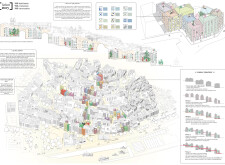5 key facts about this project
## Project Overview
The Lisbon Story project is an architectural initiative focused on revitalizing the Alfama neighborhood in Lisbon, Portugal. This endeavor seeks to balance urban renewal with heritage conservation, ensuring that modern development effectively interacts with the existing architectural and cultural landscape of the area. The design approach emphasizes rehabilitation and reconfiguration of historical structures, with the intent of enhancing the neighborhood's livability and cultural connectivity.
## Geographical Context
Located within Alfama, one of Lisbon's oldest districts, the project site is characterized by narrow streets, medieval architecture, and rich cultural heritage. Historically, Alfama has encountered urban challenges, including deterioration and a decline in community engagement. The project addresses these challenges by proposing enhancements that respect the historical significance of the area while fostering a renewed sense of community through improved accessibility and social spaces.
### Architectural Composition and Materiality
The design strategy incorporates a range of building interventions to improve structural integrity and promote community use of public spaces. Key strategies include addressing the needs of poorly maintained buildings, creating communal areas for markets and gatherings, enhancing natural light and ventilation, and establishing connections through pedestrian bridges. Local materials, such as limestone, terracotta tiles, timber, and glass, are intended to reflect the region's architectural heritage while introducing a contemporary touch. The vibrant color palette used in visual presentations distinguishes building types and proposed interventions, visually representing the narrative of revitalization for neglected areas.


















































